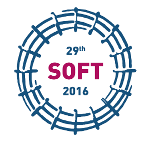Speaker
Timur Kulsartov
(Institute of Atomic Energy of National Nuclear Center of the Republic of Kazakhstan)
Description
Application of liquid lithium as a plasma facing material has some features proved by a lot of experiments with lithium devices in plasma accelerators KSPU, MK-200UG and “Plasma focus” facility. Then, the experiments carried out in operating tokamaks and stellarator (NSTX, FTU, T11-M, EAST, TJ-II) using liquid lithium and lithium CPS as intrachamber devices have shown the advisability of lithium application and its attractiveness compared to traditional materials. In continuation of this, the idea of new composite material based on capillary-porous system made from different metals and alloys filled by liquid lithium, was proposed in Russia. This material has a self-retainable surface with self-regulating lithium consumption. One of the problems connected with application of such liquid lithium systems in fusion reactors is determination of interaction parameters of plasma facing surface with working gases under conditions of fusion devices real operation, e.g. under neutron and gamma radiation.
This work presents the experimental results on study of hydrogen isotopes interaction (including tritium) with lithium CPS samples under neutron irradiation and without it. The experiments were performed at the IVG1.M research reactor (Kurchatov, Kazakhstan) at different reactor power levels and temperatures from 473 to 773 K. In studies the data on temperature dependencies of tritium release rates from lithium CPS samples under different deuterium pressures over sample were obtained.
Co-authors
Giuseppe Mazzitelli
(ENEA, RC Frascati, Frascati, Italy)
Irina Tazhibayeva
(Institute of Atomic Energy of National Nuclear Center of the Republic of Kazakhstan, Kurchatov, Kazakhstan)
Mazhyn Skakov
(Institute of Atomic Energy of National Nuclear Center of the Republic of Kazakhstan, Kurchatov, Kazakhstan)
Timur Kulsartov
(Institute of Atomic Energy of National Nuclear Center of the Republic of Kazakhstan, Kurchatov, Kazakhstan)
Viktor Baklanov
(Institute of Atomic Energy of National Nuclear Center of the Republic of Kazakhstan, Kurchatov, Kazakhstan)
Yevgen Chikhray
(Institute of Experimental and Theoretical Physics of Kazakh National University, Almaty, Kazakhstan)
Yuriy Gordienko
(Institute of Atomic Energy of National Nuclear Center of the Republic of Kazakhstan, Kurchatov, Kazakhstan)
Yuriy Ponkratov
(Institute of Atomic Energy of National Nuclear Center of the Republic of Kazakhstan, Kurchatov, Kazakhstan)
Zhanna Zaurbekova
(Institute of Atomic Energy of National Nuclear Center of the Republic of Kazakhstan, Kurchatov, Kazakhstan)

